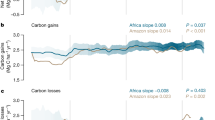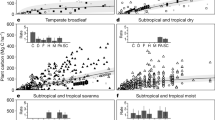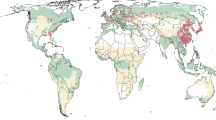Abstract
Atmospheric carbon dioxide records indicate that the land surface has acted as a strong global carbon sink over recent decades1,2, with a substantial fraction of this sink probably located in the tropics3, particularly in the Amazon4. Nevertheless, it is unclear how the terrestrial carbon sink will evolve as climate and atmospheric composition continue to change. Here we analyse the historical evolution of the biomass dynamics of the Amazon rainforest over three decades using a distributed network of 321 plots. While this analysis confirms that Amazon forests have acted as a long-term net biomass sink, we find a long-term decreasing trend of carbon accumulation. Rates of net increase in above-ground biomass declined by one-third during the past decade compared to the 1990s. This is a consequence of growth rate increases levelling off recently, while biomass mortality persistently increased throughout, leading to a shortening of carbon residence times. Potential drivers for the mortality increase include greater climate variability, and feedbacks of faster growth on mortality, resulting in shortened tree longevity5. The observed decline of the Amazon sink diverges markedly from the recent increase in terrestrial carbon uptake at the global scale1,2, and is contrary to expectations based on models6.
This is a preview of subscription content, access via your institution
Access options
Subscribe to this journal
Receive 51 print issues and online access
$199.00 per year
only $3.90 per issue
Buy this article
- Purchase on Springer Link
- Instant access to full article PDF
Prices may be subject to local taxes which are calculated during checkout



Similar content being viewed by others
References
Ballantyne, A. P., Alden, C. B., Miller, J. B., Tans, P. P. & White, J. W. C. Increase in observed net carbon dioxide uptake by land and oceans during the past 50 years. Nature 488, 70–72 (2012)
Le Quéré, C. et al. The global carbon budget 1959–2011. Earth System Science Data 5, 165–185 (2013)
Pan, Y. et al. A large and persistent carbon sink in the world’s forests. Science 333, 988–993 (2011)
Phillips, O. L. et al. Drought sensitivity of the Amazon rainforest. Science 323, 1344–1347 (2009)
Bugmann, H. & Bigler, C. Will the CO2 fertilization effect in forests be offset by reduced tree longevity? Oecologia 165, 533–544 (2011)
Huntingford, C. et al. Simulated resilience of tropical rainforests to CO2-induced climate change. Nature Geosci. 6, 268–273 (2013)
Booth, B. B. B. et al. High sensitivity of future global warming to land carbon cycle processes. Environ. Res. Lett. 7, 024002 (2012)
Feldpausch, T. R. et al. Tree height integrated into pantropical forest biomass estimates. Biogeosciences 9, 3381–3403 (2012)
Cox, P. M., Betts, R. A., Jones, C. D., Spall, S. A. & Totterdell, I. J. Acceleration of global warming due to carbon-cycle feedbacks in a coupled climate model. Nature 408, 184–187 (2000)
Friend, A. D. et al. Carbon residence time dominates uncertainty in terrestrial vegetation responses to future climate and atmospheric CO2. Proc. Natl Acad. Sci. 111, 3280–3285 (2013)
Phillips, O. L. & Gentry, A. H. Increasing turnover through time in tropical forests. Science 263, 954–958 (1994)
Fisher, J. I., Hurtt, G. C., Thomas, R. Q. & Chambers, J. Q. Clustered disturbances lead to bias in large-scale estimates based on forest sample plots. Ecol. Lett. 11, 554–563 (2008)
Condit, R. Forest turnover, diversity, and CO2 . Trends Ecol. Evol. 12, 249–250 (1997)
Chambers, J. Q. et al. Response of tree biomass and wood litter to disturbance in a Central Amazon forest. Oecologia 141, 596–611 (2004)
van Breugel, M., Martínez-Ramos, M. & Bongers, F. Community dynamics during early secondary succession in Mexican tropical rain forests. J. Trop. Ecol. 22, 663–674 (2006)
Gatti, L. V. et al. Drought sensitivity of Amazonian carbon balance revealed by atmospheric measurements. Nature 506, 76–80 (2014)
Clark, D. A., Clark, D. B. & Oberbauer, S. F. Field-quantified responses of tropical rainforest aboveground productivity to increasing CO2 and climatic stress, 1997–2009. J. Geophys. Res. 118, 783–794 (2013)
Wang, X. et al. A two-fold increase of carbon cycle sensitivity to tropical temperature variations. Nature 506, 212–215 (2014)
Marengo, J. A., Tomasella, J., Alves, L. M., Soares, W. R. & Rodriguez, D. A. The drought of 2010 in the context of historical droughts in the Amazon region. Geophys. Res. Lett. 38, L12703 (2011)
Jiménez-Muñoz, J. C., Sobrino, J. A., Mattar, C. & Malhi, Y. Spatial and temporal patterns of the recent warming of the Amazon forest. J. Geophys. Res. 118, 5204–5215 (2013)
da Costa, A. C. L. et al. Effect of 7 yr of experimental drought on vegetation dynamics and biomass storage of an eastern Amazonian rainforest. New Phytol. 187, 579–591 (2010)
Nepstad, D. C., Tohver, I. M., Ray, D., Moutinho, P. & Cardinot, G. Mortality of large trees and lianas following experimental drought in an Amazon forest. Ecology 88, 2259–2269 (2007)
Ryan, M. G., Phillips, N. & Bond, B. J. The hydraulic limitation hypothesis revisited. Plant Cell Environ. 29, 367–381 (2006)
Lieberman, D., Lieberman, M., Peralta, R. & Hartshorn, G. S. Mortality patterns and stand turnover rates in a wet tropical forest in Costa Rica. J. Ecol. 73, 915–924 (1985)
Thomas, S. C. in Size- and Age-Related Changes in Tree Structure and Function (eds Meinzer, F. C., Lachenbruch, B. & Dawson, T. E. ) Ch. 2 33–64 (Springer, 2011)
Bigler, C. & Veblen, T. T. Increased early growth rates decrease longevities of conifers in subalpine forests. Oikos 118, 1130–1138 (2009)
Di Filippo, A., Biondi, F., Maugeri, M., Schirone, B. & Piovesan, G. Bioclimate and growth history affect beech lifespan in the Italian Alps and Apennines. Glob. Change Biol. 18, 960–972 (2012)
LaDeau, S. L. & Clark, J. S. Rising CO2 levels and the fecundity of forest trees. Science 292, 95–98 (2001)
Manusch, C., Bugmann, H., Heiri, C. & Wolf, A. Tree mortality in dynamic vegetation models – a key feature for accurately simulating forest properties. Ecol. Modell. 243, 101–111 (2012)
Saleska, S. R. et al. Carbon in Amazon forests: unexpected seasonal fluxes and disturbance-induced losses. Science 302, 1554–1557 (2003)
Phillips, O., Baker, T., Brienen, R. & Feldpausch, T. RAINFOR field manual for plot establishment and remeasurement. http://www.rainfor.org/upload/ManualsEnglish/RAINFOR_field_manual_version_June_2009_ENG.pdf (2010)
Talbot, J. et al. Methods to estimate aboveground wood productivity from long-term forest inventory plots. For. Ecol. Management 320, 30–38 (2014)
Chave, J. et al. Towards a worldwide wood economics spectrum. Ecol. Lett. 12, 351–366 (2009)
Lopez-Gonzalez, G., Lewis, S. L., Burkitt, M. & Phillips, O. L. ForestPlots.net: a web application and research tool to manage and analyse tropical forest plot data. J. Veg. Sci. 22, 610–613 (2011)
Bartholomé, E. & Belward, A. GLC2000: a new approach to global land cover mapping from Earth observation data. Int. J. Remote Sens. 26, 1959–1977 (2005)
Phillips, O. L., Lewis, S. L., Baker, T. R., Chao, K. J. & Higuchi, N. The changing Amazon forest. Phil. Trans. R. Soc. Lond. B 363, 1819–1827 (2008)
Chave, J. et al. Tree allometry and improved estimation of carbon stocks and balance in tropical forests. Oecologia 145, 87–99 (2005)
Sheil, D. & May, R. M. Mortality and recruitment rate evaluations in heterogeneous tropical forests. J. Ecol. 84, 91–100 (1996)
Malhi, Y. et al. The above-ground coarse wood productivity of 104 Neotropical forest plots. Glob. Change Biol. 10, 563–591 (2004)
Lewis, S. L. et al. Tropical forest tree mortality, recruitment and turnover rates: calculation, interpretation and comparison when census intervals vary. J. Ecol. 92, 929–944 (2004)
Muller-Landau, H. C., Detto, M., Chisholm, R. A., Hubbell, S. P. & Condit, R. in Forests and Global Change ecological reviews (eds Coomes, D., Burslem, D. F. R. P. & Simonson, W. D. ) Ch. 14 462 (Cambridge Univ. Press, 2014)
Wood, S. gamm4: Generalized additive mixed models using mgcv and lme4. R package version 0.1–2. Available at http://www.inside-r.org/packages/gamm4/versions/0-1-2 (2011)
Bates, D., Maechler, M., Bolker, B. & Walker, S. lme4: Linear mixed-effects models using Eigen and S4. R package version, 1.0-4. Available at http://www.inside-r.org/packages/lme4/versions/1-0-4 (2013)
Kloke, J. D. & McKean, J. W. Rfit: Rank-based estimation for linear models. Rem. J. 4, 57–64 (2012)
R. Development Core Team. R: A Language and Environment for Statistical Computing. Available at http://www.R-project.org/ (2013)
Acknowledgements
The RAINFOR forest monitoring network has been supported principally by the Natural Environment Research Council (grants NE/B503384/1, NE/D01025X/1, NE/I02982X/1, NE/F005806/1, NE/D005590/1 and NE/I028122/1), the Gordon and Betty Moore Foundation, and by the EU Seventh Framework Programme (GEOCARBON-283080 and AMAZALERT-282664). R.J.W.B. is funded by NERC Research Fellowship NE/I021160/1. O.P. is supported by an ERC Advanced Grant and is a Royal Society-Wolfson Research Merit Award holder. Additional data were supported by Investissement d’Avenir grants of the French ANR (CEBA: ANR-10-LABX-0025; TULIP: ANR-10-LABX-0041), and contributed by the Tropical Ecology Assessment and Monitoring (TEAM) Network, funded by Conservation International, the Missouri Botanical Garden, the Smithsonian Institution, the Wildlife Conservation Society and the Gordon and Betty Moore Foundation. This paper is 656 in the Technical Series of the Biological Dynamics of Forest Fragments Project (BDFFP-INPA/STRI). The field data summarized here involve vital contributions from many field assistants and rural communities in Bolivia, Brazil, Colombia, Ecuador, French Guiana, Guyana, Peru and Venezuela, most of whom have been specifically acknowledged elsewhere4. We additionally thank A. Alarcon, I. Amaral, P. P. Barbosa Camargo, I. F. Brown, L. Blanc, B. Burban, N. Cardozo, J. Engel, M. A. de Freitas, A. de Oliveira, T. S. Fredericksen, L. Ferreira, N. T. Hinojosa, E. Jiménez, E. Lenza, C. Mendoza, I. Mendoza Polo, A. Peña Cruz, M. C. Peñuela, P. Pétronelli, J. Singh, P. Maquirino, J. Serano, A. Sota, C. Oliveira dos Santos, J. Ybarnegaray and J. Ricardo for contributions. CNPq (Brazil), MCT (Brazil), Ministerio del Medio Ambiente, Vivienda y Desarrollo Territorial (Colombia), Ministerio de Ambiente (Ecuador), the Forestry Commission (Guyana), INRENA (Peru), SERNANP (Peru), and Ministerio del Ambiente para el Poder Popular (Venezuela) granted research permissions. We thank our deceased colleagues and friends, A. H. Gentry, J. P. Veillon, S. Almeida and S. Patiño for invaluable contributions to this work; their pioneering efforts to understand neotropical forests continue to inspire South American ecologists.
Author information
Authors and Affiliations
Contributions
O.L.P., J.L. and Y.M. conceived the RAINFOR forest census plot network programme, E.G. and T.R.B. contributed to its development. R.J.W.B., O.L.P. and E.G. wrote the paper, R.J.W.B., O.L.P., T.R.F. and E.G. designed the study, R.J.W.B. carried out the data analysis, R.J.W.B., O.L.P., T.R.F., T.R.B., A.M.-M. and G.L.-G. coordinated data collection with the help of most co-authors, G.L.-G., O.L.P., S.L., T.R.B., T.R.F., R.J.W.B., J.T., E.G. and J.L. developed or contributed to analytical tools used in the analysis. All co-authors collected field data and commented on the manuscript.
Corresponding author
Ethics declarations
Competing interests
The authors declare no competing financial interests.
Additional information
Source data are available from http://dx.doi.org/10.5521/ForestPlots.net/2014_4.
Extended data figures and tables
Extended Data Figure 1 Map showing locations of plots included in this study.
The three-letter codes refer to plot codes (see Supplementary Table 1). Adjacent plots (<50 km apart) are shown as one for display purposes. Size of the dots corresponds to the relative sampling effort at that location which is calculated as the square root of plot size multiplied by square root of census length. The grey area shows the cover of all open and closed, evergreen and deciduous forests for tropical South America, according to Global Land Cover map 2000 (ref. 35).
Extended Data Figure 2 Scatterplot of mid-interval date against net AGB change, AGB productivity and AGB loss due to mortality for all data points and plots used in this analysis.
a, Biomass change. b, Productivity. c, Mortality. Points indicate the mid-census interval date, while horizontal error-bars connect the start and end date for each census interval. To illustrate variation in net AGB change over time within individual plots, examples of time series for three individual plots are show as lines.
Extended Data Figure 3 Time trends of subsets of net above-ground biomass change, above-ground woody productivity and mortality rates for plots that were continuously monitored throughout, for the periods 1990–2011, 1995–2011 and 2000–2011.
Locations for the set of plots included in the analysis for the different periods are show in the maps in lower panels. The red lines indicate the best model fit for the long-term trends using General Additive Mixed Models (GAMM) accounting explicitly for differences in dynamics between plots (red lines denote overall mean, broken lines denote s.e.m.). Estimated long-term (linear) mean slopes (sl), P values and sample sizes (n) are indicated (see Methods).
Extended Data Figure 4 Mean number of plots, interval census length and area of all plots.
The mean number of plots (red lines), mean interval census length (black lines) and mean plot area (blue lines) are shown. Note that the increased sampling in 2002 to 2004 is largely due to the short-term addition of 72 plots from one site (Ducke, north of Manaus), but this has no discernible effect on averaged biomass dynamics (Fig. 1).
Extended Data Figure 5 Biomass change, growth gains and mortalities on a per live stem basis.
a, Mean net biomass change on a per live stem basis (that is, net biomass change per stem). b, Mean growth gains per live tree (that is, mean biomass accumulation of individual trees). c, Mortality losses per stem. Analyses are based on 234 plots, excluding published studies without available stem-by-stem data. The red lines indicate the best model fit for the long-term trends using General Additive Mixed Models (GAMM) accounting explicitly for differences in dynamics between plots (red lines denote overall mean, broken lines denote s.e.m.). Estimated long-term (linear) mean slopes and significance levels are indicated (see Methods).
Extended Data Figure 6 Rates of change in number of stems plus annualized fluxes of stems bigger than 10 cm in diameter.
a–c, Mean net change in number of stems (a), number of recruits (b), and and number of dying trees (c). Analyses are based on 234 plots, excluding published studies without available stem-by-stem data. The red lines indicate the best model fit for the long-term trends using General Additive Mixed Models (GAMM) accounting explicitly for differences in dynamics between plots (red lines denote overall mean, broken lines denote s.e.m.). Estimated long-term (linear) mean slopes and significance levels are indicated (see Methods).
Extended Data Figure 7 Basal area change, productivity and mortality.
a, Mean net basal area change. b, Mean basal area productivity. c, Mean basal area mortality. Analyses are based on 234 plots, excluding published studies without available basal-area data. The red lines indicate the best model fit for the long-term trends using General Additive Mixed Models (GAMM) accounting explicitly for differences in dynamics between plots (red lines denote overall mean, broken lines denote s.e.m.). Estimated long-term (linear) mean slopes and significance levels are indicated (see Methods).
Extended Data Figure 8 Relationship among plots between mean and slopes of AGB mortality and AGB productivity.
a, Scatterplot of the slope of AGB mortality of individual plots against the slope of AGB productivity of plots. b, Scatterplot of the slope of AGB loss due to mortality of individual plots against the mean AGB productivity of plots. c, Scatterplot of the slope of AGB productivity of individual plots against the mean AGB loss due to mortality of plots. The set of plots used in this analysis (117 plots, 87 units) includes only those that had at least 10 years of data and at least three census intervals (that is, same criteria as plots shown in Fig. 2).
Extended Data Figure 9 Net AGB change or loss due to mortality versus the total monitoring length of plots, and the slope of net AGB change or mortality versus the total monitoring length of plots.
a–d, Scatterplots of net AGB change (a) or net AGB loss due to mortalityof individual plots (c) against the total monitoring length of plots, and the slope of net AGB change (b) or slope of AGB mortality of individual plots (d) against the total monitoring length of plots. None of the relationships are significant (P > 0.05). Note that the plots (117 plots, 87 units) used in b and d are only those that had at least 10 years of data and at least three census intervals (that is, same criteria as plots shown in Fig. 2). See Supplementary Information for discussion of these results.
Extended Data Figure 10 Modelled estimates of the effects of linearly increasing mortality on necromass stocks and soil organic-matter stocks.
a, Necromass stocks. b, Soil organic matter stocks. c, The estimated fluxes of carbon from the forest to the atmosphere in three scenarios: (1) assuming constant mortality rate and a lag in decomposition of dead-tree biomass (green), (2) assuming an increasing mortality rate similar to the observed trend (Fig. 1c) and a lag in decomposition as modelled (black), and (3) with increasing mortality but with all dead-tree biomass instantly respired (red). See Supplementary Information for discussion of these results.
Supplementary information
Supplementary Information
This file contains Supplementary Text & Data, Supplementary Tables 1-2 and additional references. (PDF 1077 kb)
Rights and permissions
About this article
Cite this article
Brienen, R., Phillips, O., Feldpausch, T. et al. Long-term decline of the Amazon carbon sink. Nature 519, 344–348 (2015). https://doi.org/10.1038/nature14283
Received:
Accepted:
Published:
Issue Date:
DOI: https://doi.org/10.1038/nature14283
This article is cited by
-
Phytolith assemblages reflect variability in human land use and the modern environment
Vegetation History and Archaeobotany (2024)
-
Impacts of a severe storm on carbon accumulation in coarse woody debris within a secondary Atlantic Forest fragment in Brazil
Environmental Monitoring and Assessment (2024)
-
Critical transitions in the Amazon forest system
Nature (2024)
-
Synthesis of the land carbon fluxes of the Amazon region between 2010 and 2020
Communications Earth & Environment (2024)
-
Does climate change alter the nutrient trends of Cedrela fissilis Vell. trees in the southern Brazilian Amazon?
Ecological Processes (2023)
Comments
By submitting a comment you agree to abide by our Terms and Community Guidelines. If you find something abusive or that does not comply with our terms or guidelines please flag it as inappropriate.



